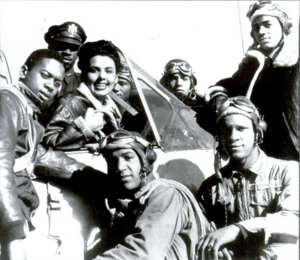Willie H. Fuller facts for kids
Quick facts for kids
Captain
Willie H. Fuller
|
|
|---|---|

Willie H. Fuller
|
|
| Birth name | George L. Knox II |
| Nickname(s) | Will |
| Born | August 2, 1919 Tarboro, North Carolina US |
| Died | January 3, 1995 (aged 75) Opa-locka, Florida US |
| Buried |
Monumental Garden South in Dade Memorial Park, Opa-locka, Florida.
|
| Allegiance | United States of America |
| Service/ |
United States Army Air Force |
| Years of service | 1942–1947 |
| Rank | Captain |
| Unit | 332nd Fighter Group |
| Awards |
|
| Alma mater | Tuskegee Institute Bachelor's degree Mechanical Industries |
| Spouse(s) | Willie (Billie) Dunson Fuller |
Willie Howell Fuller (born August 2, 1919 – died January 3, 1995) was a brave pilot in the U.S. Army Air Force. He was a fighter pilot and also taught others how to fly. He was part of the famous group called the Tuskegee Airmen, also known as the "Red Tails."
Captain Fuller was special because he was the very first Black flight instructor for single-engine planes at Tuskegee. He was the only Black flight instructor there until late 1944. He was one of 1,007 pilots who were part of the Tuskegee Airmen. He flew 76 important combat missions during World War II.
In 1942, Fuller finished the pilot training program at Tuskegee. He was honored later in his life for his important work in aviation. He once said, "Everybody figured that we could not fly and deliver under pressure. We wanted to prove that we could."
Contents
Early Life and Education
Willie Fuller was born on August 2, 1919, in Tarboro, North Carolina. He went to public schools in Tarboro. Later, he attended Tuskegee Institute. In 1942, he earned a Bachelor's degree in Mechanical Industries.
After his time in the military, Fuller married Willie (Billie) Dunson Fuller.
Military Career

In May 1940, while still a college student, Fuller received a special award for military excellence. After the attack on Pearl Harbor in December 1941, he joined the United States Army on March 16, 1942.
On August 5, 1942, Fuller completed the advanced pilot program at Tuskegee. He earned his pilot's wings and became a 2nd Lieutenant.
During World War II, Fuller flew 76 combat missions. These missions included flights over Sicily and Italy. He was part of the 99th Fighter Squadron's mission to help secure Pantelleria in 1943. He named his P-40 fighter plane "Ruthea" after his first wife. For his bravery, he received the Air Medal with an oak leaf cluster.
In 1944, Fuller returned to the United States. He became a flight instructor at Tuskegee Army Air Field. He taught other pilots how to fly single-engine planes. He was also photographed with famous actress Lena Horne when she visited Tuskegee.
Fuller left active military duty in 1947. He later became a Captain in the U.S. Air Force Reserves.
Awards and Honors
- Air Medal with oak leaf cluster
- Congressional Gold Medal (awarded to the Tuskegee Airmen in 2006)
In 1993, the Dade County Aviation Department and Florida Memorial College honored him. They recognized his important contributions to aviation.
Life After the Military
After his military service, Fuller trained civilian pilots in North Carolina. Later, he and his wife moved to LaGrange, Georgia. There, he started the first taxi cab company owned by an African American in that area. He also continued to teach civilian pilots how to fly.
By 1984, Fuller and his wife were living in Miami, Florida. He worked with the Boy Scouts in South Florida. He was a District Executive, helping to manage scouting in Dade, Broward, and Monroe Counties. He retired in 1982.
Death
Willie Fuller passed away from a heart attack on January 3, 1995. He was 75 years old. He was buried at the Monumental Garden South in Dade Memorial Park, Opa-locka, Florida.
See also
- List of Tuskegee Airmen Cadet Pilot Graduation Classes
- List of Tuskegee Airmen
- Military history of African Americans
- Dogfights (TV series)
- Executive Order 9981
- The Tuskegee Airmen (movie)


